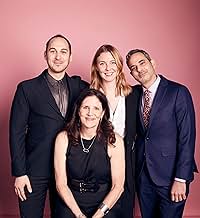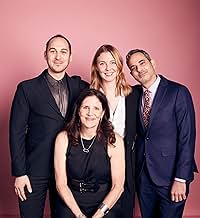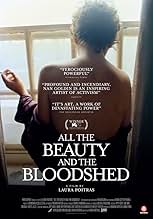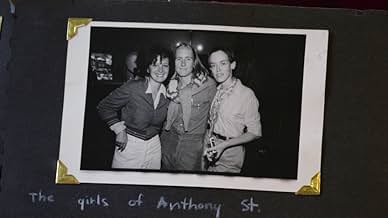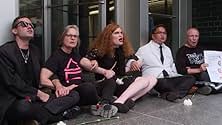ÉVALUATION IMDb
7,5/10
8,8 k
MA NOTE
Il suit la vie de l'artiste Nan Goldin et la chute de la famille Sackler, dynastie pharmaceutique grandement responsable de l'insondable bilan de l'épidémie d'opioïdes.Il suit la vie de l'artiste Nan Goldin et la chute de la famille Sackler, dynastie pharmaceutique grandement responsable de l'insondable bilan de l'épidémie d'opioïdes.Il suit la vie de l'artiste Nan Goldin et la chute de la famille Sackler, dynastie pharmaceutique grandement responsable de l'insondable bilan de l'épidémie d'opioïdes.
- Nommé pour 1 oscar
- 36 victoires et 57 nominations au total
Robert Drain
- Self - Judge
- (as Judge Robert Drain)
David Armstrong
- Self - Photographer and Friend of Nan
- (archive footage)
Bruce Balboni
- Self - Actor
- (archive footage)
Avis en vedette
This documentary about Nan Goldin and her battles throughout her life--personally and professionally--is many pronged with New York as the background. She was part of the art movement in the 1980's when AIDS started to invade that scene unabated since the administration of the time felt it was only a gay disease and would not be addressed. Her anger could have been surmised as the beginning there, but then we got a glimpse of her life growing up with the poor treatment her sister got by her parents. Things progressed from there. Her activism developed in the 1980's and continued into the age of Purdue Pharmacy's creation and rampant spread of oxycodone. The documentary may seem to be a bit of a hodgepodge of memories, but when you understand that her anger was developing almost from the moment she was born, you can understand how heartfelt her concern was for those who died around her. This was nominated as Best Feature Documentary for the Oscars It is an uncomfortable yet quite informative watch.
You would think, as an enterpreneur who had created/developed this product, as you saw that it was contributing to 100s of thousands of deaths throughout the world, you would attempt to do something, anything, to reign in the misuse and misapplication of the product. Maybe you would put some money into combatting the misuse and consequences of misuse, of your product. But no, the family put money, lots of it, into entertainment for the wealthy, the educated, the priviliged few who attend the Louvre, the Met, the Guggenheim, etc. After all, they believed "no one is forcing them to misuse our product". The film is powerful. It shows the power of people who come together to fight evil and apathy, in spite of themselves. I enjoyed the film and I would have joined them on their march for justice.
Laura Poitras' remarkable documentary ALL THE BEAUTY AND BLOODSHED which combines multiple story-lines into an incredible portrait of artist and activist, Nan Goldin. On the surface it appears as though the focus is on Goldin's attempt to bring to the public's attention the Sackler family's role as pharmaceutical kingpins during the opiod crisis. It begins with faux doctor's prescriptions and pill bottles raining down in a toney art gallery named after the Sacklers. It's a protest by Goldin's group P. A. I. N. (Prescription Addiction Intervention Now).
It's a powerful prologue, but, Poitras isn't simply interested in an advocacy documentary film here. It's a dense and intense exploration of Goldin, the person and the artist, and how her personal journey informed her activism.
Goldin is interviewed at length, and her personal writings and art are revealed in the most intimate manner. Goldin's photography evolved naturally. She was driven to document her own life and, from there, depicted an entire underground scene that had rarely been exposed to not only the art world - but, to the larger public. Goldin's fluid sexuality brought her to Provincetown and later the Burroughs of New York City, photographing everything and everyone she came in contact with. She never intentionally was putting together a portfolio - it just happened. The photographs are as private and personal as could be. Goldin never shied away from her innermost relationships, nor that of her circle of friends. That frankness is what eventually brought her to the recognition by the art world - even as it scandalized many of them. When AIDS hit her community, Goldin learned a lesson from the Act Up movement that carried on to her founding of P. A. I. N..
While all of that played out (eventually) in the public's eye, Poitras reveals Goldin's personal family life. Her strained relationship with her parents, and, most poignantly, of that with her sister who was institutionalized. Her sibling's story shows how a young woman's 'rebelliousness' can be struck down by the system and a forced dependency on drugs and a form of enslavement. It's something that Goldin carries with her to this day, including her own bout with opiods.
ALL THE BEAUTY AND THE BLOODSHED carries a lot on its plate. Poirtras' great achievement here is that no section of the movie feels out of place, nor does any part of it feel in any manner slighted. It's all of a piece melding Goldin's intensely personal quest, art and sense of social purpose.
Breathtaking.
It's a powerful prologue, but, Poitras isn't simply interested in an advocacy documentary film here. It's a dense and intense exploration of Goldin, the person and the artist, and how her personal journey informed her activism.
Goldin is interviewed at length, and her personal writings and art are revealed in the most intimate manner. Goldin's photography evolved naturally. She was driven to document her own life and, from there, depicted an entire underground scene that had rarely been exposed to not only the art world - but, to the larger public. Goldin's fluid sexuality brought her to Provincetown and later the Burroughs of New York City, photographing everything and everyone she came in contact with. She never intentionally was putting together a portfolio - it just happened. The photographs are as private and personal as could be. Goldin never shied away from her innermost relationships, nor that of her circle of friends. That frankness is what eventually brought her to the recognition by the art world - even as it scandalized many of them. When AIDS hit her community, Goldin learned a lesson from the Act Up movement that carried on to her founding of P. A. I. N..
While all of that played out (eventually) in the public's eye, Poitras reveals Goldin's personal family life. Her strained relationship with her parents, and, most poignantly, of that with her sister who was institutionalized. Her sibling's story shows how a young woman's 'rebelliousness' can be struck down by the system and a forced dependency on drugs and a form of enslavement. It's something that Goldin carries with her to this day, including her own bout with opiods.
ALL THE BEAUTY AND THE BLOODSHED carries a lot on its plate. Poirtras' great achievement here is that no section of the movie feels out of place, nor does any part of it feel in any manner slighted. It's all of a piece melding Goldin's intensely personal quest, art and sense of social purpose.
Breathtaking.
All the Beauty and the Bloodshed can join Fire of Love in the club of Oscar-nominated documentaries from 2022 that would have been more worthy winners than Navalny. It's admittedly a small club, but I feel like both of those movies have moments that demonstrate documentary filmmaking at its best.
In the case of All the Beauty and the Bloodshed, it's probably the final 15-20 minutes that shines the brightest. It can be a slow and somewhat uneven feeling documentary at some points, but it builds to some phenomenal and emotionally hard hitting final scenes. The rest of the documentary still tends to hit far more often than it misses, but I did get the sense it may have been a tiny bit too long, and while I respect the choice not to tie together its two primary narratives more explicitly, part of me was waiting for them to collide more directly at a point. Still, leaving some of that up to the viewer felt like a deliberate choice, and I can respect that.
It follows Nan Goldin, with the film both recounting her life story from the 1950s to the 1990s and detailing her activism against the Sackler family and their role in the opioid epidemic in the 2010s. The latter might be more interesting narratively, but the former has the more interesting presentation, seeing as Goldin's an accomplished artist/photographer, and the documentary frequently relies on her work to serve as visuals.
It's a heavy and often sad documentary, dealing with mental illness, addiction, corruption, censorship, the AIDS crisis, discrimination, and domestic violence. It might be upsetting to some viewers as a result, but I think it was best not to pull punches (so long as people know what they're in for before deciding to watch it). It's a largely powerful documentary that I think will stick with me. Not perfect, but it has some amazing sequences that were very striking and moving.
In the case of All the Beauty and the Bloodshed, it's probably the final 15-20 minutes that shines the brightest. It can be a slow and somewhat uneven feeling documentary at some points, but it builds to some phenomenal and emotionally hard hitting final scenes. The rest of the documentary still tends to hit far more often than it misses, but I did get the sense it may have been a tiny bit too long, and while I respect the choice not to tie together its two primary narratives more explicitly, part of me was waiting for them to collide more directly at a point. Still, leaving some of that up to the viewer felt like a deliberate choice, and I can respect that.
It follows Nan Goldin, with the film both recounting her life story from the 1950s to the 1990s and detailing her activism against the Sackler family and their role in the opioid epidemic in the 2010s. The latter might be more interesting narratively, but the former has the more interesting presentation, seeing as Goldin's an accomplished artist/photographer, and the documentary frequently relies on her work to serve as visuals.
It's a heavy and often sad documentary, dealing with mental illness, addiction, corruption, censorship, the AIDS crisis, discrimination, and domestic violence. It might be upsetting to some viewers as a result, but I think it was best not to pull punches (so long as people know what they're in for before deciding to watch it). It's a largely powerful documentary that I think will stick with me. Not perfect, but it has some amazing sequences that were very striking and moving.
The film attempts a profile of a photographer, but without laying groundwork to make the case for why she is, in thee filmmaker's perspective, a great artist. Viewers are shown a few slideshows of her work, images that are often uninteresting on their own -- without first being contextualized -- and then sequences of B-roll of the photographer shuffling around her studio and directing installations of her work. I got the the impression that if I were already enamored with the photographer, then I might have watched these sequences with rapt attention. Instead, knowing next to nothing about the artist, I found them boring -- and this was all within the first 15 minutes!
There are vastly more powerful films about photographers, searing works about the opioid epidemic, beautiful films about artistic process. This film intersects with each of those genres, but in an insubstantial and unmemorable way.
The buzz around this work -- and there is a lot of buzz -- seems rooted in the celebrity of the filmmaker and its subject. That's ironic, for the film appears to seek its power from themes larger than any individual, yet winds up relevant only if underpinned by the fame surrounding its maker and central character. Like the reviewer here PedroPires90 wrote ("Unfocused," March 3, 2023), "honestly it was hard to find the strength to finish it."
There are vastly more powerful films about photographers, searing works about the opioid epidemic, beautiful films about artistic process. This film intersects with each of those genres, but in an insubstantial and unmemorable way.
The buzz around this work -- and there is a lot of buzz -- seems rooted in the celebrity of the filmmaker and its subject. That's ironic, for the film appears to seek its power from themes larger than any individual, yet winds up relevant only if underpinned by the fame surrounding its maker and central character. Like the reviewer here PedroPires90 wrote ("Unfocused," March 3, 2023), "honestly it was hard to find the strength to finish it."
Le saviez-vous
- AnecdotesThe title of the film is a reference to Nan Goldin's older sister, Barbara Holly Goldin. It's a direct quote from a mental health evaluation of Barbara during her time at an institution. She died by suicide in 1965, at the age of 18. This film and Nan Goldin's 1986 "The Ballad of Sexual Dependency" are dedicated to her.
- Citations
Nan Goldin: Photography is like a flash of euphoria.
- Bandes originalesThe Cold Song
Performed by Klaus Nomi
Meilleurs choix
Connectez-vous pour évaluer et surveiller les recommandations personnalisées
- How long is All the Beauty and the Bloodshed?Propulsé par Alexa
Détails
- Date de sortie
- Pays d’origine
- Sites officiels
- Langue
- Aussi connu sous le nom de
- Hayatın Tüm Acıları ve Güzellikleri
- Lieux de tournage
- Ville de New York, New York, États-Unis(Metropolitan Art Museum protest)
- sociétés de production
- Consultez plus de crédits d'entreprise sur IMDbPro
Box-office
- Brut – États-Unis et Canada
- 500 082 $ US
- Fin de semaine d'ouverture – États-Unis et Canada
- 28 803 $ US
- 27 nov. 2022
- Brut – à l'échelle mondiale
- 1 483 975 $ US
- Durée1 heure 53 minutes
- Couleur
- Mixage
- Rapport de forme
- 1.78 : 1
Contribuer à cette page
Suggérer une modification ou ajouter du contenu manquant

Lacune principale
What is the streaming release date of All the Beauty and the Bloodshed (2022) in Brazil?
Répondre



